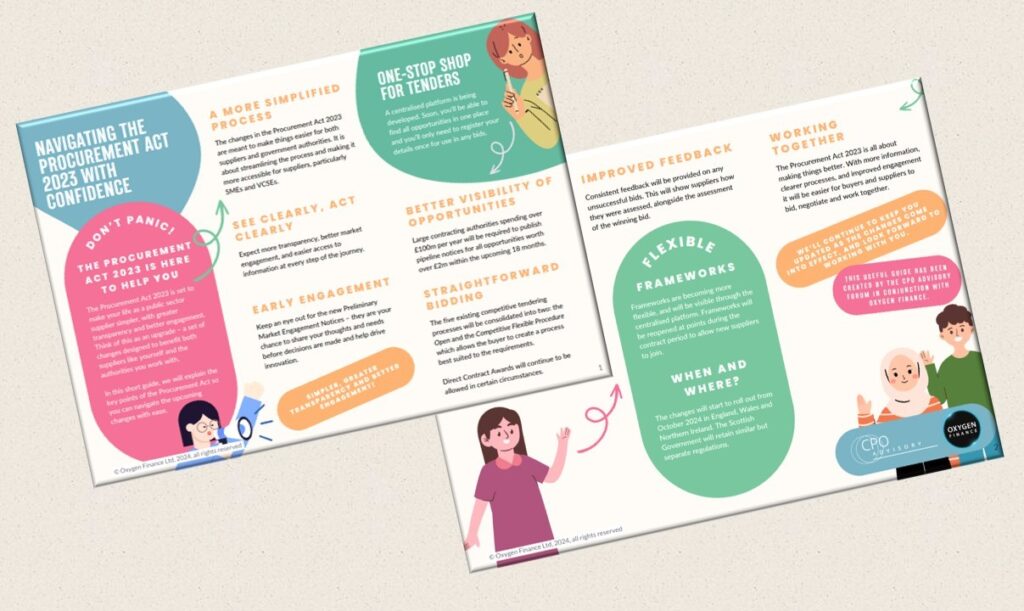Having access to public sector spend and pre-procurement data gives suppliers a head start over the competition, but how are successful sales teams using this data to best effect and is it just sales that benefit?
We sat down with Ariane Oliveira, Customer Success Manager at Oxygen Finance, to discover the best use cases and examples where pre-procurement and spend data is working hardest.
Hi Ari, for those that don’t already know you, tell us a little about your role.
Hi, I get to work with our amazing clients to ensure that their teams get maximum value from their Insights data. I act as an ‘advisory resource’, investigating usage patterns and journeys to better assist different personas to find their quick wins based on their specific needs. We home in on the areas that will save them the greatest time; improving visibility and gaining comprehensive understanding of potential and existing buyers and the wider market.
Where do people typically start when it comes to utilising the spend data?
Primarily, they want to know how the public sector spend its money and learn about opportunities first. We can reveal upcoming public sector contracts months and even years before formal tendering, providing the opportunity to build relationships earlier and be more successful.
Knowing which public sector organisations are already active in your market is key to focussing your sales efforts and understanding the competition. Obviously, it’s important to know when tenders and contract data are released and those that are re-tendering soon, and to see which suppliers have been successful – having access to that information in one place saves enormous amounts of time and research.
The real power for sales comes in the pre-engagement information though – to understand what’s coming up soon, and that lets you be ahead of the curve. This is where you get to shape the brief and expectations – introducing what’s new in your sector and show where the innovation is – perhaps there are new ways of delivering a service that the buying organisation hasn’t previously considered. Trying to shoehorn that into a tender response later misses out a golden opportunity to educate and influence. You’ll also be able to use historical data, such as previous awards, competitors and any incumbents, to distinguish your offering further.
What are some of the ways people get in front of buyers though and act on this information?
Many suppliers are successfully making use of the buyer days. Going into those armed with some of the information we’ve mentioned, rather than cold or with a standard introduction or questions, makes your conversations more focussed and relevant and you’ll know exactly what you want to achieve through the event. Share ideas and approaches that play to your strengths. You’ll be able to make a much more compelling argument and share expertise, which in turn will make yourself more interesting and credible to the buyer as a result.
Presumably, increased knowledge of upcoming opportunities and the competitive landscape, also helps with more accurate forecasting?
Absolutely, because you have early knowledge of tenders and renewals and an accurate view of competitors your short-term and long-term forecasting can become more accurate, as you can see what is coming up not just next year but 2,3,4 years in advance.
You’ll also be more aware of risks to that pipeline, so for example, if there are extensions being discussed at pre-procurement then you know that those dates will be put back. You don’t want to find out about those things at short notice – if you thought a contract was going to come up for renewal in 12 months or go out to tender again, but then you can see extensions are being discussed, then you already know that it’s a risk for this next year and you can delay the expected close.
For sales and marketing working together, they can be more proactive in their targeting.
Certainly, sometimes marketing teams use Insights data as much as sales, driving targeted campaigns when people are approaching renewal. I’ve heard many examples where the data is used to trigger campaigns, so 6 to 12 months in advance of the renewal they start their focussed campaigns and engagement through events and other activities. With an account-based approach, those campaigns become highly relevant, and you can find out so much more about who you are selling against too, to best position yourselves and to highlight your strengths versus their weaknesses. The more information you have, the more compelling your case will be.
Traditionally, this information is hard to share between sales and marketing teams whereas with Insights everyone can build their approach from the data. It also safeguards against information purely being held in a particular salesperson’s head or known by a particular team where there’s a risk of that hard-won information leaving the business or not being used as effectively as it should be.
Of course, you can also research new opportunities to influence – looking where particular authorities have high spend or growing levels of spend in your service/product area, such as software, and if they’re not already a client, targeting them to capture some of that business.
If you have a portfolio of products its also good to look at wallet share in other categories, to see where you could increase your work with a client.
Are there ways to use the data beyond sales and marketing too?
More accurate forecasting of pipeline, in terms of upcoming opportunities and the chances of success, makes it much easier for the business to plan and commit to their growth plans.
It can also be used to identify areas of increasing spend though, and new areas for investment – such as EV technologies. This can impact the range and type of solutions you offer and prioritise in your development programmes. Many local authorities are looking for ideas on how suppliers can help address some of the biggest challenges they face, so the pre-procurement data offers a lot of opportunity there to understand your existing base and the wider market.
One client explained an interesting scenario where they were planning locations for regional depots. From an operational perspective, you could say we’ve got a contract award coming up and it’s in the North-East and then look at what the contract renewals were around that area and decide if you needed a full branch or a hub in order to plan for possible expansion. It helps them map out logistically how they can best serve their clients and make sure they have the capacity they need to meet future demand.
Thanks Ari. Any closing comments?
Most importantly. We want you to be successful in your bidding with the public sector and to work together effectively for the benefit of everyone, and I’m here to support that. We want you to save precious time and win more business!
If you’re an existing user and want to get more from Insights, then contact Ari direct.
If you’re interested in learning more about Insights, visit these pages or book in a call.




